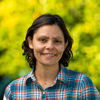Danna Staaf

Josh Weaver
Danna Staaf is a freelance science communicator with a PhD in marine biology. Her writing has appeared in Science, KQED, Earther, and io9, and her first book, Squid Empire: The Rise and Fall of the Cephalopods (now reprinted as Monarchs of the Sea: The Extraordinary 500-Million-Year History of Cephalopods), was named one of the best science books of 2017 by NPR. She created the science outreach program Squids4Kids and visits schools at every grade level, as well as venues from museums to libraries to tech companies. She lives in San Jose with her spouse, children, and innumerable plush octopuses.
Interview
What was your favorite book when you were a child?
I had so many favorites! Two of my most lovingly re-read books were Dealing with Dragons by Patricia C. Wrede and Octopus and Squid: The Soft Intelligence by Jacques Cousteau and Philippe Diole.
What’s your favorite line from a book?
“What have you found?”
“A few dirty rocks, a weird root, and some disgusting grubs.”
“On your first try??”
“There’s treasure everywhere!”
As a kid I was obsessed with Calvin and Hobbes, the comic strip by Bill Watterson, and I constantly quoted lines back and forth with my brother and friends. I loved Calvin partly because he was so different from me—he definitely would’ve called me a goody-two-shoes—but I also related to his overactive imagination and his enthusiasm for nature. When I think of 19th-century naturalist Jeanne Villepreux-Power collecting everything from fossils and seashells to caterpillars and snails, I’m certain she would agree, “there’s treasure everywhere!”Who are your top three favorite authors or illustrators?
Here are three picks from the very much longer list of authors and illustrators I admire: Ursula Vernon, Sydney Padua, and Neil Gaiman.
Why did you want to become an author or illustrator?
I’ve been writing stories and drawing pictures ever since I learned how. Even if I hadn’t found a publisher, I’d still be doing it. When I was quite young, I thought I was only interested in writing fiction, and I kept trying to turn my school essays into fantasy stories. As I got older, I encountered narrative nonfiction, notably the memoirs of animal-lovers like Jacques Cousteau, James Herriot, and Gerald Durrell. I realized that true stories could be as fun and fascinating as made-up ones, a discovery that dovetailed with my growing interest in marine biology. I proceeded to spend ten years studying ocean animals. During that time, my greatest job satisfaction came from sharing what I learned with friends, family, and random strangers on the beach who wanted to know why I was measuring dead squid. In my experience, everyone is interested in the world around them and full of questions, but not everyone gets the opportunity to look for answers! I decided to become a full-time writer to help make science accessible to people of all ages and backgrounds. (And I still write fiction, too!)
Do you have any advice for future authors or illustrators?
Don’t be shy to practice imitation! Imitation is different from plagiarism, or taking credit for someone else’s work. Imitation is a natural part of our learning process—it’s how we learn to speak, to dance, to change a tire. Imitating other writers and artists stretches our creative muscles and helps us pick up new techniques. I took an “Imitations” poetry class in college; we read and imitated dozens of poets including Pablo Neruda, e.e. cummings, Mei Yao-ch’en, and Leonidas of Tarentum. I find that imitation teaches me about the craft of writing and loosens my brain when it feels stuck. Of course, it’s important to be clear and honest with ourselves and others when we imitate. I always make a note on my paper or in my document, so I don’t risk forgetting and thinking later that the ideas or style were all my own.


